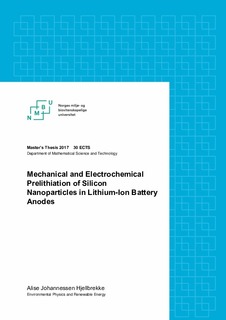| dc.contributor.advisor | Grimenes, Arne Auen | |
| dc.contributor.advisor | Lai, Samson | |
| dc.contributor.advisor | Ulvestad, Asbjørn | |
| dc.contributor.advisor | Mæhlen, Jan Petter | |
| dc.contributor.author | Hjellbrekke, Alise Johannessen | |
| dc.date.accessioned | 2018-05-29T12:54:41Z | |
| dc.date.available | 2018-05-29T12:54:41Z | |
| dc.date.issued | 2017 | |
| dc.identifier.uri | http://hdl.handle.net/11250/2499638 | |
| dc.description.abstract | Silicon (Si) is one of the most promising anode materials for the next generation lithium ion batteries, as it can store up to ten times the capacity compared to the conventional graphite anode. However, with its alloying capacity follows great volume expansions resulting in capacity fade during the early cycles.
In this study, prelithiation was studied as a possible solution to reduce the irreversible capacity loss seen during the first cycle, and to potentially increase cycle life.
Two methods for prelithiation of silicon nanoparticles (SiNPs) were developed: electrochemical prelithiation (EP) and mechanical prelithiation (MP). In the EP process the half-cells were electrochemically cycled one cycle with a rate of C/20, before disassembled, washed, and reassembled into new, now prelithiated, half-cells. In the MP process a Si electrode with electrolyte was sandwiched with a piece of Li foil between two glass dishes.
Both methods were shown to successfully prelithiate the Si electrodes, and a degree of prelithiation close to 100 % was obtained with both EP and MP. Through a time-dependent study it was seen that the degree of prelithiation increases with prelithiation time, and that prelithiation potentially can be regulated by time and mass measurements. The results showed that a degree of prelithiation > 90 % could be reached in just 60 min of MP.
Both reference and prelithiated Si electrodes were assembled into coin cells with lithium metal as the counter electrode, and electrochemically cycled. The results showed no significant change in electrochemical cycling signature, and scanning electron microscopy (SEM) measurements showed that the structure of the SiNPs was maintained during prelithiation. Even though the discharge capacity decay was seen reduced for the prelithiated cells during the first cycles, they retained as poor cycle life as the reference cells of ca. 50 cycles. Two of the MP cells with the highest degree of prelithiation showed however slightly increased cycle lives up to ca. 60 cycles.
Additionally, prelithiated cells were cycled on two different limited capacity cycling programs, one limiting the lithiation process, the other limiting the delithiation process. Both were limited by the capacity of 372 mAh/gSi, similar to the theoretical value of the graphite anode. All cells cycled 500 cycles with no significant decrease in discharge capacity. | nb_NO |
| dc.description.abstract | Silisium (Si) har vist seg å vere eit av dei mest lovande anodemateriala for neste generasjons litium-ionbatteri. Silisium har ei høg legeringsevne med litium, og kan i teorien levere opp til ti gongar så mykje kapasitet som den meir tradisjonelle grafittanoden. Men, med denne legeringsevna følgjer ei enorm volumendring som resulterer i degresjon av kapasitet i tideleg sykling. Lang nok levetid for batteria til å bli kommersielle er endå ikkje nådd.
I denne studia har prelitiering blitt undersøkt som ei mogeleg løysing for å redusere det irreversible kapasitetstapet sett i tideleg sykling, samt potensielt sett forlenge levetida til cellene. To prelitieringsmetodar har blitt utvikla: elektrokjemisk prelitiering (EP) og mekanisk prelitiering (MP). I EP prosessen blei kvar celle sykla ein gong i ein batteritestar med ein rate på C/20, før dei blei demonterte, vaska og remonterte til nye, no prelitierte, halvceller. I MP prosessen blei litiumfolie lagt direkte oppå Si elektrodane med berre elektrolytt imellom, og klemt saman mellom to glasskåler.
Begge metodane viste suksessfull prelitiering, og ein litieringsgrad på omlag 100 % blei nådd med både EP og MP. Gjennom ei tidsavhengig studie, blei det sett at litieringsgraden aukar med prelitieringstid, og det blei vist at prelitiering potensielt sett kan bli regulert ved hjelp av tids- og massemålingar. Resultata viste òg at ein litieringsgrad > 90 % kan bli nådd med berre 60 min MP.
Både referanse- og prelitierte Si elektrodar blei monterte i halvceller med litium-metall som referanse-elektrode, og elektromeisk sykla i ein batteritestar. Resultata viste ingen forskjell i elektrokjemisk syklingsignatur mellom dei prelitierte og ikkje-prelitierte cellene. Dette blei vidare forklart av elektronmikroskopi (SEM) som viste at Si nanopartiklane overlevde prelitiering utan betydelige endringar i nanostruktur. Sjølv om degraderinga av kapasiteten i dei første syklusane blei redusert for dei prelitierte cellene, oppnådde dei same levetid som referansecellene på ca. 50 syklusar. To av MP cellene med høgast litieringsgrad blei vist å nå ein noko lenger levetid opp mot 60 syklusar.
I tillegg blei dei prelitierte cellene sykla på to forskjellige program med avgrensa kapasitet. Det eine programmet avgrensa litieringskapasiteten, mens det andre programmet avgrensa delitieringskapasiteten. Begge programma var avgrensa av kapasiteten 372 mAh/gSi, som er den teoretiske kapasiteten til grafittanoden. Alle cellene sykla med neglisjerbar kapasitetsdegresjon for 500 syklusar. | nb_NO |
| dc.language.iso | eng | nb_NO |
| dc.publisher | Norwegian University of Life Sciences, Ås | nb_NO |
| dc.rights | Attribution-NonCommercial-NoDerivatives 4.0 Internasjonal | * |
| dc.rights.uri | http://creativecommons.org/licenses/by-nc-nd/4.0/deed.no | * |
| dc.subject | Prelithiation | nb_NO |
| dc.subject | Anode materials | nb_NO |
| dc.subject | Lithium-ion batteries | nb_NO |
| dc.subject | Silicon | nb_NO |
| dc.title | Mechanical and electrochemical prelithiation of silicon nanoparticles in lithium-ion battery anodes | nb_NO |
| dc.type | Master thesis | nb_NO |
| dc.description.version | submittedVersion | nb_NO |
| dc.subject.nsi | VDP::Matematikk og Naturvitenskap: 400::Fysikk: 430 | nb_NO |
| dc.source.pagenumber | 126 | nb_NO |
| dc.relation.project | Norges forskningsråd: Siproco Fobeliba, 255116. | nb_NO |
| dc.description.localcode | M-MF | nb_NO |

